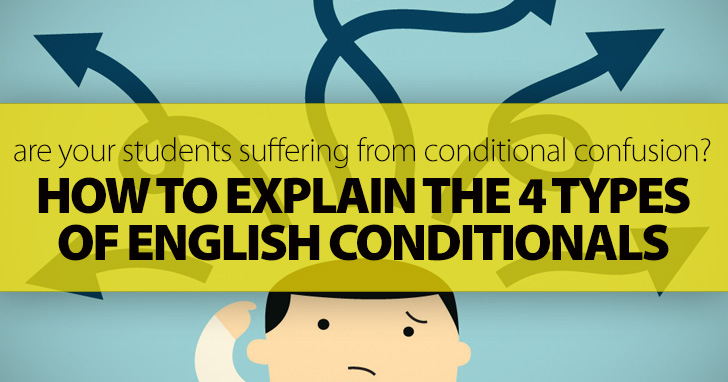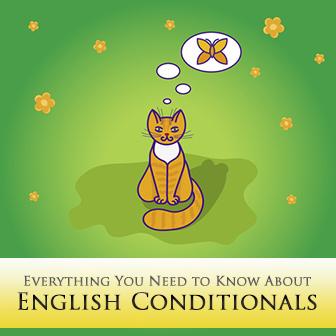Are Your Students Suffering From Conditional Confusion?: 4 Simple Steps To Explain The 4 Types Of English Conditionals


Conditionals are a sentence structure in English used to talk about events in the past, present or future that may or may not have happened. These events depend on another event or condition, which is expressed in an if-clause in the sentence. In English, there are 4 basic types of conditionals you and your students will need to understand.

No matter which type of conditional you are using, the basic sentence construction will be the same. Conditionals are expressed in a complex sentence, that is a sentence with one a independent clause and one dependent clause. Conditionals use the dependent clause to express the condition required for the second event. This condition is expressed in an if-clause. If the weather is good…If he gets the job…If we had been at the concert… The main clause in the complex sentence expresses the result of that condition. …we will go on a picnic…he will pay you back…we would have seen the movie star. The order of these two clauses does not matter, sometimes the if-clause is at the beginning, sometimes at the end of the sentence, but a conditional sentence in English must have both parts.
Zero conditionals are also called real conditionals. They express something that is certain or real, a result that always happens providing the condition in the if-clause is met. These results may be general facts, universal truths, or personal results in a given situation. For example,
To form a zero conditional, the verb in the if-clause should appear in the present tense. The verb in the result clause should also appear in the present tense.
First conditionals are results that are likely to occur; they will probably happen though the outcome is not certain. With first conditionals, there is a possibility that they will not turn out as one would expect, but that possibility is slight. When forming first conditionals in English, the if-clause appears in the present tense, and the result clause appears in the simple future. For example,
First conditionals are not always simple, however. In more complex sentences, you can use other modals in the result clause depending on the outcome’s level of certainty.
The if-clause, as well, is not limited to the present tense in first conditionals. The verb can also appear in the present progressive, present perfect, and simple future.
Second conditionals, also called unreal conditionals, express a situation that is not real or is not likely to happen. The if-clauses expresses the condition that would need to be met, and the result clause expresses what would happen if it were met. However, the speaker who uses a second conditional does not think that these events will occur. For second conditionals about a current situation, the if-clause is not true.
When talking about future events, a second conditional if-clause expresses a condition that is not likely to happen.
In both sentences, the if-clause is expressed in the simple past, and the result clause is expressed with “would” plus the base verb. Other modals can also be used in the result clause.
In formal language situations, the verb “be” is conjugated as “were” rather than “was” in the if-clause when the subject is I, you, she/she/it. For informal speech, was is an acceptable alternative.
Third conditionals are also unreal conditionals, but they express an unreal situation in the past. The condition occurred in the past, and it was not met; therefore the results did not happen. The conditional sentence expresses the idea of “what if”.
To form an unreal past conditional, the if-clause verb appears in the past perfect, and the result clause uses “would have” plus the past participle of the main verb.
But if your students can get a grasp on these four basic conditional structures, they will have the foundation they need to imagine limitless possibilities.